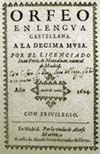 Portrait of Lope de Vega |
1.- Félix Lope de Vega Carpio (1562-1635) is, without doubt, one of the first and most representative poets of the 17th century. His first literary sounds were already made in the General Ballads of 1600 and in the Best of Illustrious Poets (1605), collected by Pedro de Espinosa.
Lope always based his poetry on his personal love-life, and so, the best way to study his poems is to follow his loves.
The first phase can be considered to be until 1602, the date in which the first edition of his Rhymes appeared, accompanied by another series of poems. Until then, his poetry was based on other authors´ anthologies.
His first works are ballads dedicated to Elena Osorio, called Filis. This first poetic cycle featured the Moorish ballads,in which the lady calls her lover Zaide. A little later came the poems dedicated to his legitimate wife, Isabel de Urbino, under the name of Belisa.Pastoral ballads were abundant in these poems. This first stage saw the appearance of the sonnet, a type of verse which Lope developed from the beginning through to the end of his poetry writing.
 Cover of Lope´sRhymes with The Beauty of Angela (1602) |
2.- 1602 saw the first edition of Rhymes, dedicated to the poet Juan de Arguijo. It appeared alongside two epic poems: La Dragontea, about the pirate, Sir Francis Drake, and The Beauty of Angela, along the lines of Ariosto, which is the title of this book. The Two Hundred Sonnets which Lope published, introduced us to Lucinda, Micaela Luján´s poetic name. As well as this, there was reference to Elena Osorio in his best sonnets, like that which begins “Suelta mi manso, mayoral extraño”. In 1604, the first book was added to. We see a variety of themes – mythological, historical, biblical or personal and family – and the presence of eclogues, epistles, etc. The third edition, of 1609, includes the famous work The New Art of Writing Comedies. This can be considered an oratorial piece, a short discourse in which Lope justifies his right to break all poetic rules, whenever the work was crowned with success. He always referred to the old writers, from Aristotle to those of his time in order to support his discourse. |
|
We remember that earlier, in 1612, his son Félix Lope edited Shepherds of Bethlehem, a collection of infantile poems about the birth of Christ ,and also Four Soliloquies.
The Sacred Rymes show a move towards spiritual poetry, resulting from a religious crisis which ordaned him a priest. In this book, sonnets like “¿Qué tengo yo que mi amistad procuras?” o “Pastor, que con tus silbos amorosos” are worth mentioning. His arguments with Góngora began during these years, whom however, he copied from time to time. In 1621, he published The Nightingale and other poems where he introduced us to Amarilis,an image of Marta de Nevares. Three years later, La Circe, an epic poem and other rhymes, making up a mixture, in the style of the time. Now Lope published some of his most famous, almost Petrarchan, love sonnets. Also around these years, he settled his enmity with Góngora. |
 Cover of Sacred Rhymes (1614) |


